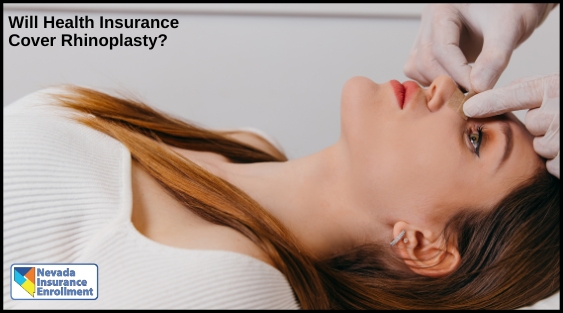Does Health Insurance Pay For a Nose Job?
Nose jobs, officially referred to as rhinoplasty, are among the most common types of plastic surgery. Patients opt for this procedure for a myriad of reasons from improving their face’s symmetry to alleviating breathing troubles. Whether an individual’s health insurance covers the surgery comes down to two factors, including whether it is paid for under their specific health insurance plan and whether the surgery is medically necessary.

When Does Health Insurance Cover Rhinoplasty?
Health insurance may cover a nose job if the procedure is medically necessary. If the individual does not have full function of their nose due to a deviated septum, a birth deformity, inflammation from chronic allergies, or damage from an accident or injury, the surgery may be considered medically necessary and therefore covered under their health insurance policy. The health insurance company usually requires the individual to undergo nonsurgical treatments for these issues before authorizing payment for the surgery.
ACA-compliant health insurance plans generally cover a large portion of surgical costs for medically necessary rhinoplasty. Each plan is different, however, so before someone schedules their surgery, it is a good idea for them to determine what their cost-sharing responsibility will be.
When Does Health Insurance Not Cover Rhinoplasty?
As is the case with all elective surgeries, rhinoplasty is not covered by health insurance when the procedure is not medically necessary. Cosmetic rhinoplasty changes the overall appearance of the individual’s nose by reshaping it or reducing its size. Commonly, people seek this surgery to create a narrower nose bridge or remove a bump on the bridge, reduce or widen the nostrils, straighten a crooked nose, reshape the tip, or change the angle between the nose and the upper lip.
Cosmetic rhinoplasty can provide a boost to an individual’s confidence and help bring alignment to their facial features. However, while the surgery may correct some psychological problems, it does not address any medical problems. For this reason, patients generally foot the entire bill, which averages $5,483.

Partial Coverage for Rhinoplasty
Occasionally, when someone is undergoing rhinoplasty for medical reasons, such as to fix a deviated septum, they may decide to correct a cosmetic problem at the same time. In this case, their health insurance only covers the cost of the portion of the procedure that addresses the medical issue. While it may be hard to predict exactly what insurance will cover and what the patient’s responsibility will be, it may be helpful to request an itemized breakdown of the projected cost of the procedure.
Comprehensive Health Insurance Coverage with Nevada Insurance Enrollment
Even medically necessary surgeries that are covered by health insurance can be a significant expense. At Nevada Insurance Enrollment, our health insurance agents help you review your policy to determine what you should expect to pay for medically necessary rhinoplasty. We can also help you compare health insurance policies across several companies to help you make educated decisions regarding your coverage.
Recent Posts

Hidden Pitfalls of Cheap Auto Insurance
Car accidents can be expensive, and your auto insurance policy is your best protection against financial devastation if the unexpected happens. While state-minimum coverage is definitely better than no coverage at all, a high percentage of scenarios shows it’s not enough for most drivers.




How Financing Your Car Affects the Insurance Premium
However, you may end up paying a higher premium than someone who has not financed their vehicle. If you make payments on your vehicle, your lender requires you to have comprehensive and collision coverage on top of the state minimum requirements.




Adding Uninsured / Underinsured Motorist To Your Policy
Uninsured and underinsured motorist coverage is used when you are hit by a driver that has insufficient coverage or no coverage at all. This optional coverage helps to compensate you for damages, up to your policy limit.
Search This Website
Most Popular Pages
By page visits (this month)
#1) Health Insurance Subsidy Chart
#2) Health Insurance
#3) Health Insurance WITH a Subsidy
#4) Insurance Blog
#5) Request a Quote
Top 5 Most Popular
By page visits (this month)
#1) Health Insurance Subsidy Chart
#2) Health Insurance
#3) Health Insurance WITH a Subsidy
#4) Insurance Blog Posts
#5) Request a Quote
Recent Posts
I Witnessed A Car Accident; What Do I Do?
A car accident can happen in the blink of an eye and witnessing one can be scary. After an auto accident, all drivers involved are required to stay at the scene where information is exchanged for auto insurance purposes. But what should you do if you witness a car wreck?
Accidents / Vandalism: Does Auto Insurance Cover Personal Belongings?
Personal items such as a tablet, wallet, or any personal valuables are not generally covered in your auto insurance policy. Those items would be covered in your homeowners/renters policy. You would have a deductible to pay for first, and then you’d need to consider the consequences of a claim on your homeowners policy.
Windshield / Glass Coverage
Windshield / glass coverage pays the amount of a covered glass loss, and as an added perk, it has a low deductible. Your insurer will cover the full costs of the repairs up to your policy limit, and as long as the costs of the damages don’t exceed your coverage limit, you’ll pay only your small deductible.
Term Life Insurance vs. Whole Life Insurance
Term life insurance policies will often have terms of one year to 30 years. Typically, the monthly premium (monthly payment) stays the same throughout the term of the policy. Whole life insurance provides coverage your whole life and it includes something called “cash value”. Think of it like a mini savings account attached to the policy.